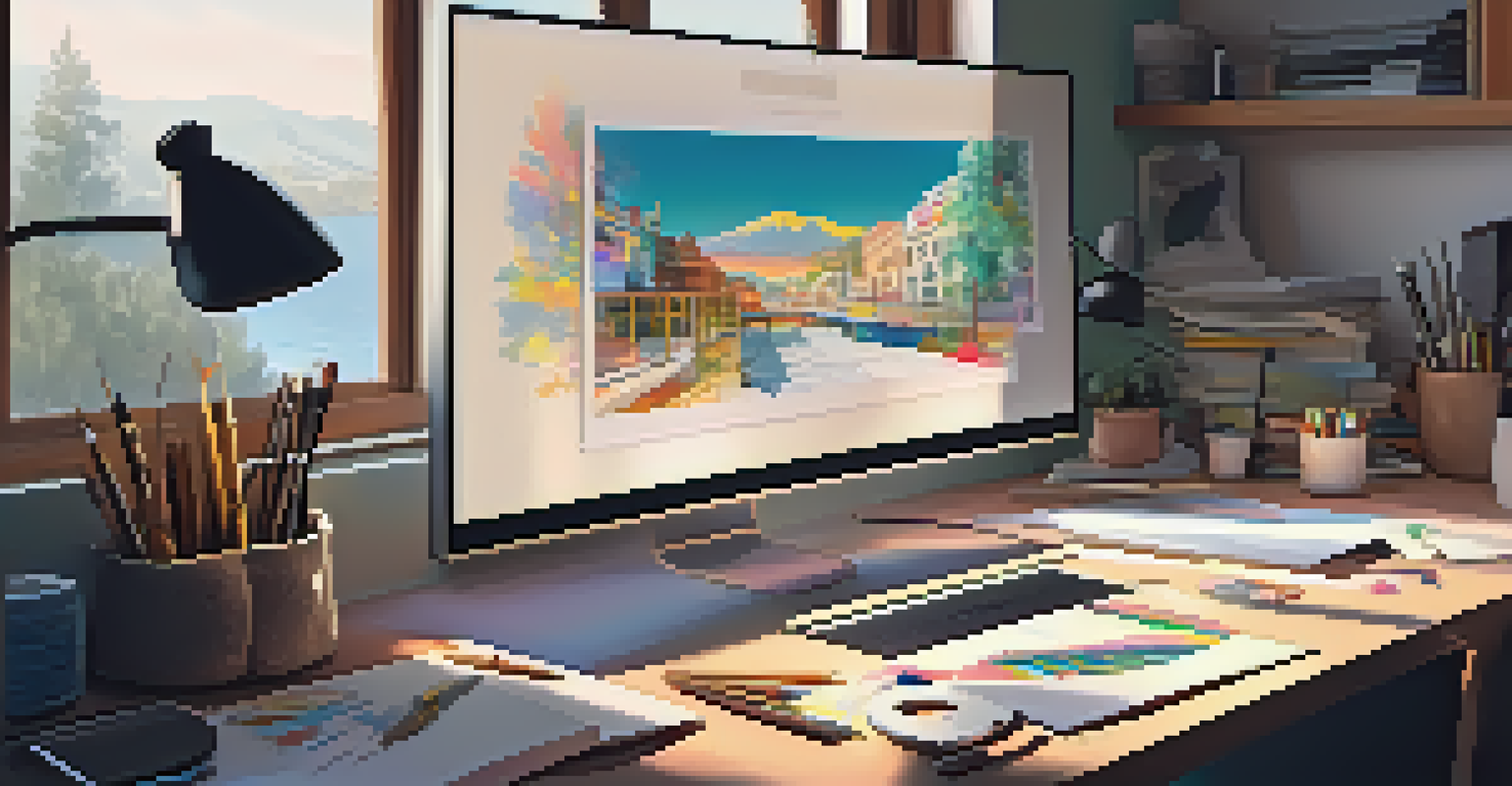Digital Illustration Techniques: From Concept to Creation Explained

Understanding the Basics of Digital Illustration
Digital illustration is a captivating blend of creativity and technology. Unlike traditional methods, it allows artists to use software tools to create artwork that can be easily modified and shared. This technique has become increasingly popular due to its versatility and accessibility, making it ideal for both budding artists and seasoned professionals.
Creativity takes courage.
At its core, digital illustration involves creating images using digital tools, such as graphic tablets and design software. This approach not only streamlines the artistic process but also opens up a world of possibilities with layers, brushes, and effects that can enhance creativity. By understanding the basic principles, you can lay a solid foundation for your digital art journey.
Moreover, digital illustration encompasses various styles and techniques, from vector art to digital painting. Each method offers unique advantages, catering to different artistic preferences and project requirements. By exploring these basics, you set yourself up for success as you delve deeper into the world of digital illustration.
Finding Inspiration and Developing Ideas
Inspiration is the lifeblood of any creative endeavor, and digital illustration is no exception. Whether it's nature, architecture, or everyday life, ideas can stem from anywhere. Keeping an inspiration board, either digitally or physically, can help you gather visuals, color palettes, and themes that resonate with you.

Once you have a collection of inspirations, the next step is to develop your ideas further. This could involve sketching rough drafts or brainstorming concepts that align with your vision. Don't hesitate to experiment with different styles or compositions; sometimes, the best ideas come from playful exploration.
Digital Illustration Basics
Digital illustration merges creativity with technology, using software tools for versatile and easily modifiable artwork.
Additionally, engaging with other artists or communities can spark creativity. Sharing ideas, receiving feedback, and participating in challenges can not only enhance your skills but also broaden your perspective. Remember, inspiration is everywhere; you just need to keep your eyes and mind open!
Choosing the Right Tools and Software
Selecting the right tools is crucial in the digital illustration process. A good graphic tablet can provide a more intuitive drawing experience, mimicking the feel of traditional media. Popular brands like Wacom and Huion offer various options catering to different budgets and skill levels, making it easier to find one that suits you.
Every artist was first an amateur.
In addition to hardware, the software you choose plays a significant role in your workflow. Programs like Adobe Illustrator, Procreate, and Clip Studio Paint each have unique features tailored for different styles of digital art. Familiarizing yourself with these tools can help you unlock their full potential, enhancing your ability to create stunning illustrations.
Don’t forget about the importance of tutorials and online resources. Many platforms offer free or paid courses that can expedite your learning process. Investing time in mastering your tools can significantly elevate the quality of your artwork.
Sketching: The Foundation of Your Illustration
Sketching is the first tangible step in the illustration process and serves as the foundation for your final piece. This stage is all about getting ideas down on paper (or screen) without worrying too much about perfection. Allow yourself to create loose, free-flowing sketches that capture the essence of your concept.
As you sketch, consider the composition, proportions, and overall flow of your illustration. This phase is not just about detail; it's about visualizing how different elements interact within your artwork. Embrace the freedom of sketching; mistakes or unexpected lines can lead to creative discoveries.
Finding Inspiration
Inspiration can come from various sources, and keeping a collection of visuals can help in developing unique ideas.
Once you feel confident with your sketches, you can begin refining them into more detailed drafts. This is the time to correct any anatomical or compositional issues. Remember, even the greatest artists started with rough sketches; it’s a vital part of the creative journey.
Inking: Bringing Your Sketch to Life
Inking is where your sketches start to transform into polished illustrations. This process involves defining the outlines and key features of your artwork, giving it structure and clarity. Many artists prefer to use a digital pen or brush tool to replicate the fluidity of traditional inking.
During this stage, focus on line weight and texture. Varied line thickness can add depth and interest to your illustration, helping to guide the viewer's eye. Don't hesitate to explore different styles of inking, from bold and graphic to delicate and intricate, depending on the mood you want to convey.
Also, keep in mind that inking is an opportunity to refine your drawing further. You can adjust proportions, enhance details, or even change elements that don’t quite fit. The beauty of digital illustration lies in its ability to allow for continuous improvement and iteration.
Coloring: Adding Depth and Emotion
Coloring is where your illustration truly comes to life. It’s not just about filling in spaces; it’s about evoking emotions and creating a mood. Start by selecting a color palette that aligns with your concept, considering the emotional impact of colors—warm hues can create a sense of comfort, while cool tones often evoke calmness.
Many artists find it helpful to use layers when coloring. This allows you to separate different elements, making it easier to adjust colors and apply shading without affecting the entire illustration. Experimenting with blending modes and opacity can also yield stunning effects that enhance the overall depth of your work.
Importance of Final Touches
Final adjustments and proper presentation can significantly elevate the quality of your digital illustrations.
Don’t be afraid to play with highlights and shadows. These elements can add dimension and realism to your illustration, guiding the viewer's eye and emphasizing key features. Remember, coloring is a chance to express your artistic voice, so have fun and let your creativity shine!
Final Touches: Refining and Presenting Your Work
The final touches are what transform a good illustration into a great one. This stage involves reviewing your work for any inconsistencies or areas that could use more refinement. Small adjustments, like enhancing contrast or adding texture, can significantly elevate your overall piece.
Additionally, consider the presentation of your artwork. Whether you plan to share it online or print it, proper formatting is essential. Make sure to export your work in the correct resolution and file type to maintain quality, especially if it will be viewed on different platforms.

Finally, don’t forget to seek feedback before sharing your work widely. Constructive criticism from fellow artists or friends can provide valuable insights that you might have overlooked. Once you’ve made your final adjustments, it’s time to showcase your masterpiece with pride!